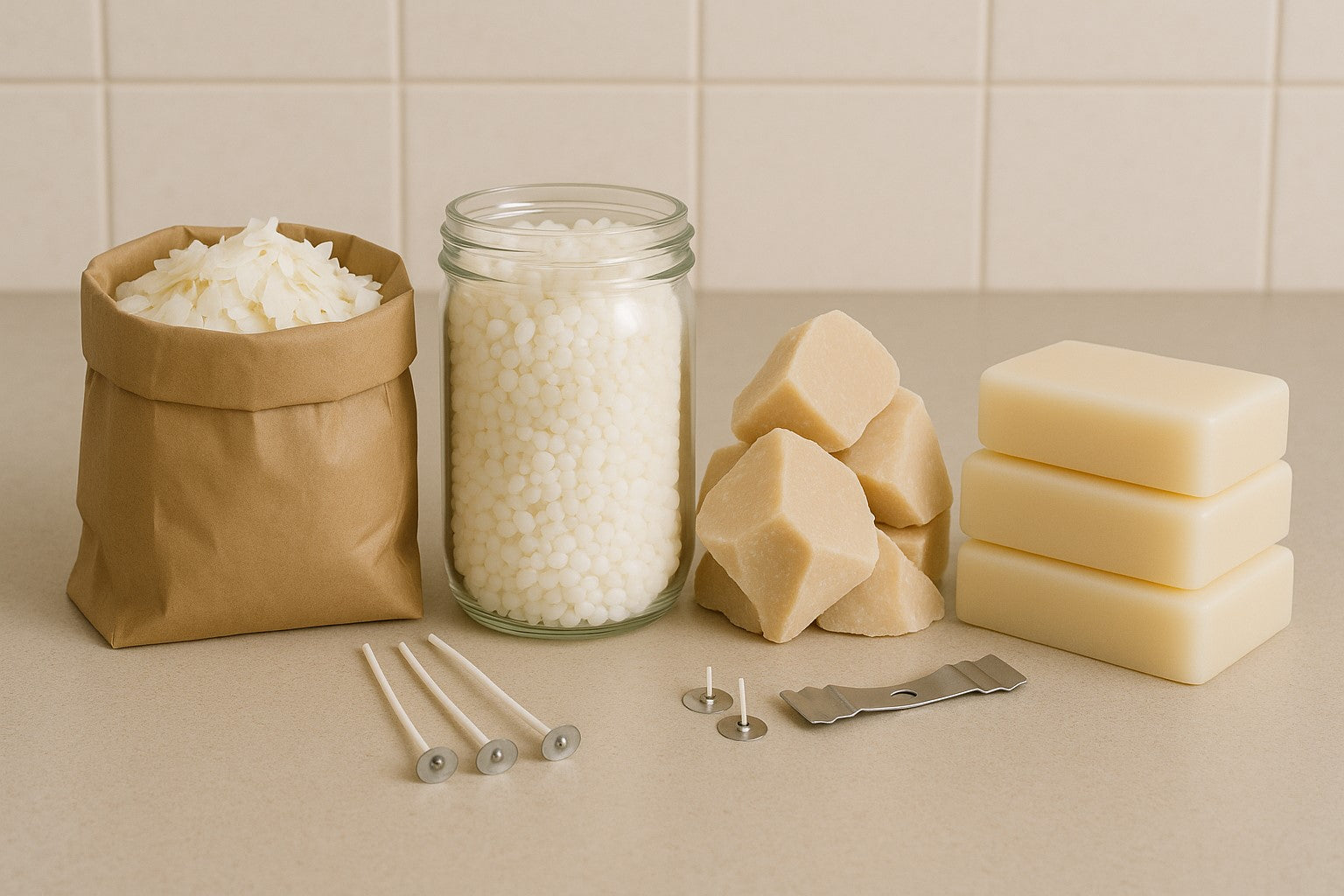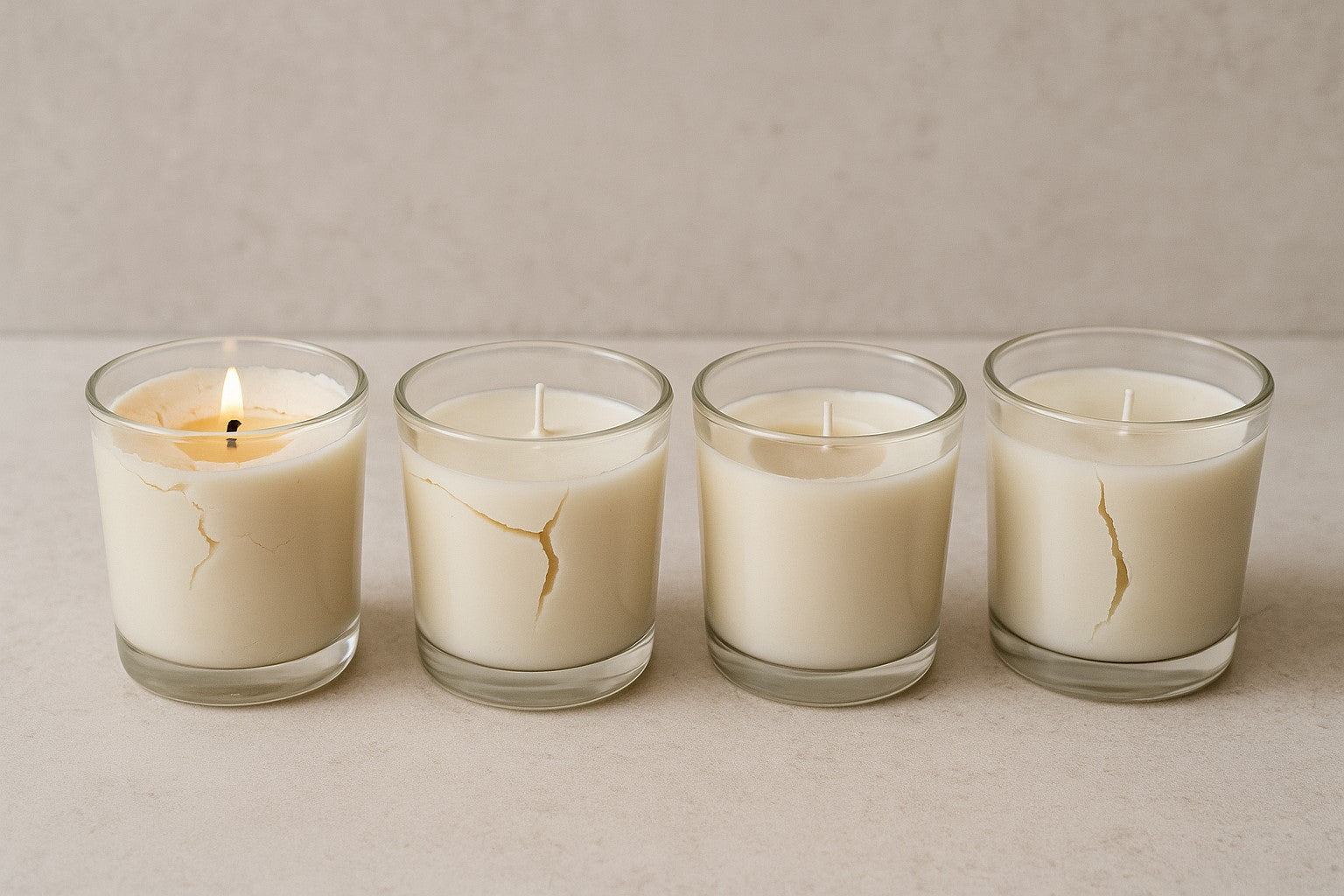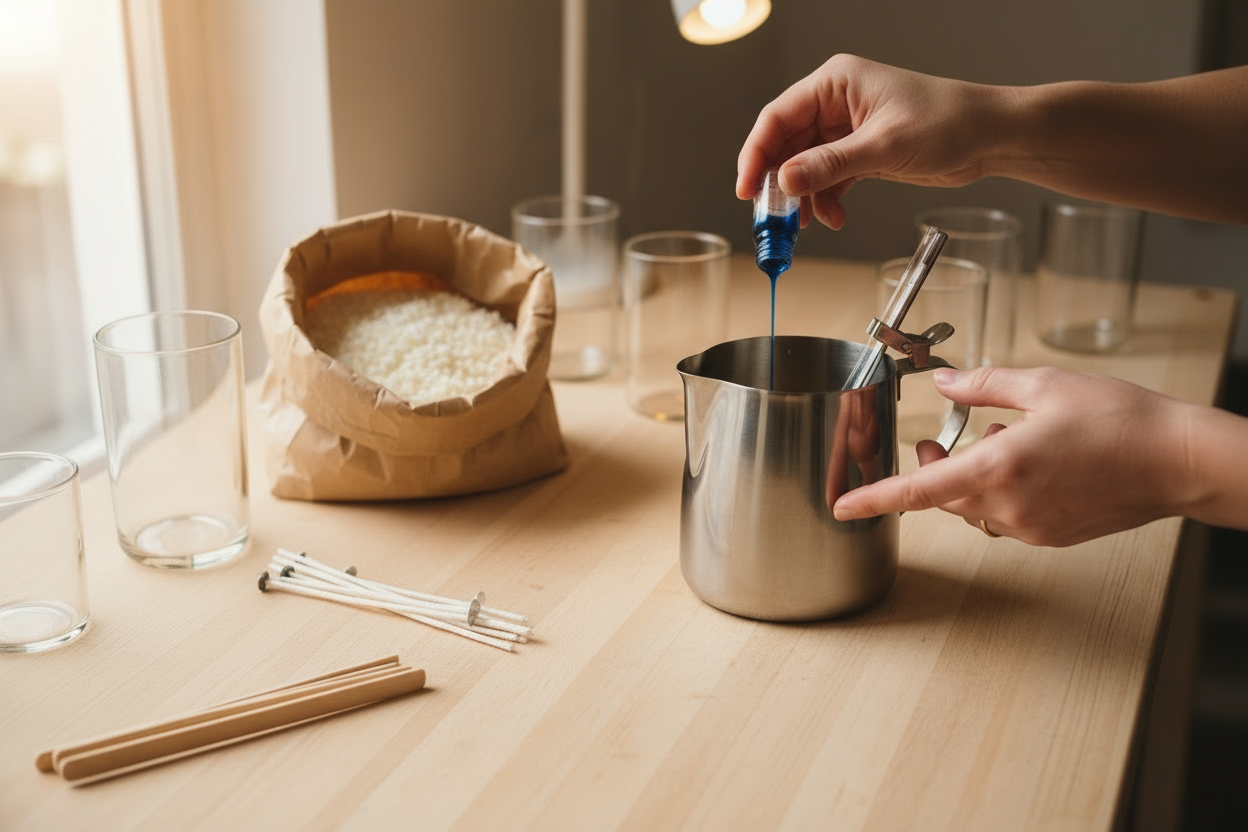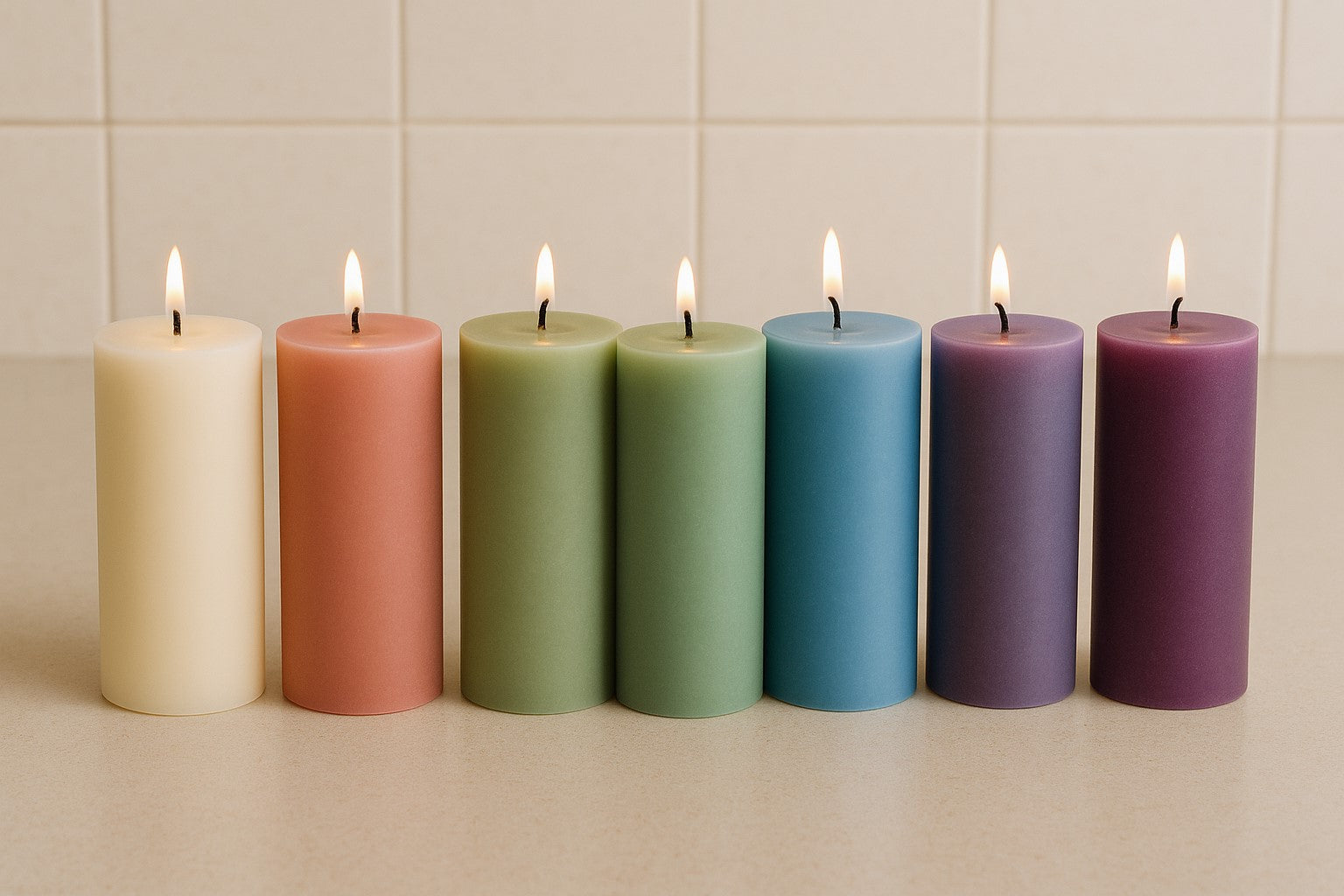Articles

Article
How to Make a Lavender and Chamomile Candle
Making your own candles at home is a fun and rewarding way to create a personalized and relaxing atmosphere. This lavender and chamomile candle recipe is perfect for unwinding after a long day. It combines the soothing scents of lavender and chamomile with the warm glow of a handmade candle.
Ingredients for Lavender and Chamomile Candle:
1 cup soy wax flakes (or any other candle wax)
15-20 drops lavender fragrance oil
10-15 drops chamomile fragrance oil
Alternatively 15-25 drops lavender chamomile oil
1 candle wick
1 heat-resistant glass jar or tin (8 oz size works well)
Double boiler or heatproof bowl
Thermometer (optional, but helpful)
Pencil or chopstick (to hold the wick in place)
Instructions for DIY Lavender Chamomile Candle:
Prepare Your WorkspaceMake sure your workspace is clean and free of any flammable materials. Gather all your ingredients and equipment. Lay down some newspaper or parchment paper to catch any spills.
Melt the WaxUsing a double boiler or a heatproof bowl over a pot of simmering water, melt the soy wax flakes slowly. Stir occasionally with a spoon until the wax is completely melted and reaches about 170°F (77°C). If you don’t have a thermometer, the wax should be fully liquid with no remaining flakes.
Incorporate Fragrance OilsAdd 15-20 drops of lavender fragrance oil and 10-15 drops of chamomile fragrance oil to the melted wax. Stir well to combine the oils with the wax. Adjust the number of drops based on your fragrance preference, but be cautious not to add too much, as this can affect how the candle burns.
Attach the WickPlace the wick in the center of your glass jar or tin. You can use a dab of melted wax or a wick sticker to secure it to the bottom of the container. Wrap the top of the wick around a pencil or chopstick and balance it on the rim of the jar to keep the wick centered.
Pour the WaxSlowly pour the melted wax into the container, ensuring the wick remains centered. Leave about half an inch of space at the top. Let the candle sit undisturbed for a few hours until the wax hardens completely.
Trim the WickOnce the candle has cooled and solidified, trim the wick to about 1/4 inch above the wax. Your lavender and chamomile candle is now ready to use!
FAQ for Lavender and Chamomile Candle:
1. How long does it take for the candle to cool and set?The candle typically takes about 4-6 hours to cool and set completely. For best results, let it sit overnight before lighting.
2. Can I use other types of wax?Yes, you can use beeswax, paraffin, or coconut wax. Just be aware that different waxes have varying melting points and burn times.
3. What if my candle cracks when it cools?Cracking can occur if the wax cools too quickly. Pouring the wax at the right temperature (around 150°F or 65°C) and letting it cool gradually can help prevent this.
4. How can I make the scent stronger?You can increase the amount of fragrance oil slightly, but be cautious not to exceed 10% of the total wax weight to ensure a safe burn.

Article
What is Paraffin Wax? Everything You Need to Know
Paraffin wax is a versatile and widely used material with applications in candles, skincare, and beyond. Though, it is one of the most common waxes used in candles. Understanding the answer to "What is paraffin wax?" can better inform decision-making for new candle products. This guide explores the origins, properties, and benefits of paraffin wax.
Understanding Paraffin Wax
Paraffin wax is a white or colorless soft solid derived from petroleum, coal, or shale oil. It was first developed in the 19th century and quickly became popular due to its versatility and affordability.
What is paraffin wax made of? It consists of a mixture of saturated hydrocarbons, also known as alkanes. These hydrocarbons contribute to its smooth texture and low melting point, making it ideal for a variety of applications.
Paraffin wax chemical formula: While the specific chemical composition can vary, it primarily comprises alkanes with the general formula CnH2n+2.
Properties of Paraffin Wax
Paraffin wax has several unique properties that make it useful across industries:
Low Melting Point: Paraffin melts between 115°F and 154°F (46°C to 68°C), depending on its specific composition. This makes it easy to work with in applications like candle making.
Smooth Texture: Its soft, pliable nature makes it ideal for skincare products and therapeutic treatments.
Odorless: Paraffin wax is neutral, allowing it to be combined with other ingredients like dyes, fragrances, and essential oils.
Water Resistance: It’s hydrophobic, meaning it repels water, which is why it’s used for coating and waterproofing.
Versatility: Paraffin wax can be molded, shaped, or layered, adapting to a variety of uses.
Advantages of Paraffin Wax
Paraffin wax offers several benefits:
Affordable and Accessible: Its wide availability and low cost make it a go-to material for many applications.
Easy to Use: Its low melting point and pliable nature make it simple to work with, especially for DIY projects like candle making.
Customizable: Paraffin wax blends well with dyes and fragrances, allowing for endless creative possibilities.
Frequently Asked Questions About Paraffin Wax
Q: What does paraffin wax do in candles?
A: It serves as the primary fuel for candles. It holds fragrance and color well, burns cleanly, and creates a smooth finish, making it a popular choice for candle making.
Q: What is paraffin wax made of?
A: Paraffin wax is composed of saturated hydrocarbons derived from petroleum, coal, or shale oil. Its primary components are alkanes with the general formula CnH2n+2.
Q: What is paraffin wax used for in industrial applications?
A: In industries, paraffin wax is used as a lubricant, corrosion inhibitor, and release agent. It’s also employed in waterproofing and insulating applications.
Q: How is paraffin wax different from other waxes?
A: Paraffin wax is derived from petroleum and has a lower melting point compared to beeswax or soy wax. It’s also more affordable and versatile, making it suitable for a wide range of uses.

Article
How Much Wax Do I Need?
How Much Wax Per Candle? A Complete Guide
Making candles at home can be a fun and rewarding hobby, but knowing how much wax per candle is crucial for success. Wax is typically measured by weight, and since wax is less dense than water, you’ll need to adjust the volume for your specific container. In this guide, we’ll walk through how much wax you’ll need for various candle sizes, including 8 oz, 10 oz, and 12 oz candles.
How Much Wax to Make a Candle?
To make a candle, it's essential to use the right formula. Start by calculating the volume of your container and convert it to weight. Wax weighs about 20% less than water, so for each candle, you’ll need to use a little less wax than the container's total volume. This ensures you get a well-filled candle without spilling over.
For instance, to figure out how much wax to make a candle, if your container holds 10 oz, you’ll need about 9 oz of wax. This process works for any size container, which leads us to the next section.
How Much Wax for 8 oz Candle?
When making an 8 oz candle, you won’t need a full 8 oz of wax due to the weight-to-volume ratio. You’ll generally need around 6.5 to 7 oz of wax per 8 oz candle container. This will leave enough room for your wick and any fragrance or dye you might want to add.
How Much Wax for 10 oz Candle?
For those working with a 10 oz container, you’ll need about 9 oz of wax to make a candle. As with the 8 oz candle, measuring by weight will give you an accurate result. This ensures a balanced candle without overfilling your container.
How Much Wax for 12 oz Candle?
If you are using a 12 oz container, plan on using roughly 10.5 to 11 oz of wax. This amount allows for a perfect fill without leaving gaps at the top of your candle.
How Much Wax Does It Take to Make a Candle?
Whether you’re making one candle or several, knowing how much wax it takes is essential. To calculate the total amount of wax you need for a batch, multiply the amount of wax needed per candle by the number of containers. If you’re making five 12 oz candles, for example, you’d need about 52.5 oz of wax in total.

Article
Top 10 Scents for Women: Find the Best Fragrance for You
When it comes to selecting the best scents for women, personal preference plays a huge role. Whether you love something light and floral or prefer deeper, sultry notes, a well-chosen fragrance can leave a lasting impression. To help you find the perfect match, here’s our guide to the top 10 fragrances for women that are both popular and timeless.
1. Sweet Pea: Light and Floral
Sweet Pea is often at the top of lists for the best perfume scents for women, thanks to its light, floral aroma. This fragrance is perfect for those who enjoy a fresh and feminine scent, making it a favorite among many.
2. Bergamot: Fresh and Citrusy
Bergamot, with its citrusy and refreshing scent, is one of the most popular fragrances for women. Known for its uplifting and invigorating qualities, it’s perfect for daytime wear, especially during spring and summer.
3. Toffee: Rich and Sweet
Toffee is a popular scent amongst women because it evokes feelings of nostalgia, comfort, and indulgence, fitting perfectly with their love for sweet, playful fragrances. Its connection to food culture and uniqueness also appeals to their desire for personal expression and standout scents.
4. Amber: Deep and Warm
Amber remains a top contender among the best perfume scents for women because of its rich and warm qualities. Its comforting depth makes it ideal for evening wear, adding a sense of mystery to any look.
5. Lavender: Fresh and Relaxing
Known for its calming properties, lavender is also one of the top 10 fragrances for women. Its fresh, herbal notes make it perfect for those who love a clean and natural scent, great for everyday use.
6. Vanilla: Cozy and Sweet
Vanilla continues to be a favorite in the fragrance world, standing strong as one of the best scents for women. Its cozy, sweet scent is ideal for those who prefer something comforting and classic.
7. Cherry: Youthful and Tart
Cherry is a popular scent for women because it’s the perfect mix of sweet and a little tart, giving it a fun yet sophisticated vibe. It’s fruity and bold, which feels youthful and feminine, but also has a touch of indulgence and luxury, making it a go-to for everything from everyday wear to something a bit more special.
8. Patchouli: Earthy and Sultry
Patchouli brings an earthy, sultry vibe to any fragrance. Often featured in perfumes with deeper, woodier notes, it’s one of the popular scents for women who want a more complex, bold fragrance.
9. Jasmine: Sweet and Sensual
Jasmine is always considered one of the best fragrances for women, admired for its sweet, romantic scent. It’s frequently used in high-end perfumes and can add a touch of sensuality to any fragrance blend.
10. Musk: Soft and Clean
Musk offers a clean and subtle scent that many women adore. It’s among the most popular fragrances for women because of its understated yet sophisticated presence, making it perfect for those who want something timeless and versatile.
With so many options available, finding the right scent can be a fun and personal journey. These top 10 fragrances for women offer a variety of notes, ensuring there’s something for everyone. To explore these scents and create your own custom blends, visit The Flaming Candle for an array of high-quality fragrance oils and supplies.

Article
How to Fix Candle Tunneling: A Guide to Saving Your Candles
Few things are as frustrating for candle lovers as candle tunneling—when the wax burns straight down the middle, leaving a wall of unused wax around the edges. Not only does this ruin the candle’s aesthetic, but it also wastes a lot of wax. The good news? Tunneling can often be fixed or prevented with a few simple techniques. This guide will explain how to fix candle tunneling, why it happens, and how to stop it from occurring in the first place.
What is Candle Tunneling?
Candle tunneling occurs when the wax melts unevenly, creating a tunnel down the center of the candle while leaving the outer edges untouched. Instead of burning evenly across the surface, the flame consumes only a small portion of the wax. Over time, the tunnel deepens, making it difficult for the wick to stay lit or for the wax to melt evenly.
Why Do Candles Tunnel?
Understanding why candles tunnel can help you address and prevent the issue. There are several common causes:
Short Burn Times: If you extinguish the candle before the melted wax reaches the edges of the container, it sets unevenly, creating a “memory ring” that restricts future burns.
Wick Size: A wick that is too small for the candle’s diameter may not generate enough heat to melt the wax evenly across the surface.
Wax Type: Some waxes, especially harder varieties, require longer burn times to fully liquefy.
Improper Candle Care: Failing to trim the wick or allowing drafts to affect the flame can lead to uneven burning.
How to Fix Candle Tunneling
If your candle has already tunneled, don’t worry—it can often be salvaged. Here’s how to fix candle tunneling:
Aluminum Foil Method:
Wrap a piece of aluminum foil around the top of the candle, leaving a small opening in the center for the flame.
Light the candle and let it burn for about an hour. The foil traps heat, allowing the wax to melt evenly across the surface.
Spoon or Knife Method:
Once the candle is extinguished and the wax is cool, use a spoon or knife to scrape away the excess wax around the tunnel.
Relight the candle and ensure it burns long enough to reset the wax memory.
Heat Gun or Hair Dryer:
Carefully use a heat gun or hair dryer to melt the top layer of wax until it evens out. Avoid overheating, as this can cause the wick to shift.
How to Prevent Candle Tunneling
Prevention is key when it comes to avoiding the frustration of a tunneling candle. Follow these tips to ensure an even burn:
The First Burn is Critical: Always let the candle burn long enough for the entire surface to melt to the edges during its first use. This creates a full wax pool and prevents memory rings.
Trim the Wick: Keep the wick trimmed to about ¼ inch. A properly trimmed wick ensures a steady, even flame.
Avoid Short Burns: Candles should burn for at least one hour per inch of diameter. For example, a 3-inch-wide candle needs a 3-hour burn to melt evenly.
Store Properly: Keep your candles in a cool, dry place away from direct sunlight to prevent wax from softening or warping.
Choose the Right Wick: When making your own candles, ensure the wick size matches the container’s diameter and the type of wax used.
Frequently Asked Questions About Candle Tunneling
Q: Can all tunneling candles be fixed?
A: Most can, especially if the tunneling isn’t too severe. The aluminum foil method is particularly effective for mild tunneling.
Q: How long should I burn a candle to prevent tunneling?
A: Burn the candle for at least one hour per inch of its diameter. This allows the wax to fully melt across the surface.
Q: Is tunneling more common with certain waxes?
A: Yes, harder waxes like paraffin or beeswax are more prone to tunneling if not burned long enough. Softer waxes like soy are less likely to tunnel.
Q: Can I prevent tunneling in homemade candles?
A: Absolutely! Use the correct wick size for the container, and ensure the wax is evenly poured and set.
Q: Why does my candle wick get buried?
A: This often happens when tunneling worsens and the wax walls collapse inward. Fixing the tunneling before it deepens can prevent this issue.
Candle tunneling doesn’t have to mean the end of your favorite candle. By following these tips to fix candle tunneling and taking preventative measures, you can enjoy a longer, more even burn. Whether you’re rescuing a tunneling candle or ensuring your next one burns beautifully, these strategies will keep your candles looking and performing their best.

Article
What's The Difference Between Paraffin & Soy Wax?
Soy vs Paraffin Wax Candles: Which Should You Choose?
Choosing between soy vs paraffin wax candles often comes down to your personal preferences and priorities. Each type of wax offers distinct advantages that cater to different needs, whether you value vibrant colors or eco-friendly materials.
Soy Wax vs Paraffin Wax: Key Considerations
Choose Paraffin Wax If:
Bright, Bold Colors Matter to You: Paraffin wax holds color exceptionally well, making it the best choice if you want candles with vivid, eye-catching colors.
You Dislike Frosting: Frosting, a natural occurrence where the wax appears cloudy, is much less noticeable in paraffin candles. If a smooth, polished look is important, paraffin wax is your go-to.
You Want Strongly Scented Candles Quickly: Paraffin wax allows for a strong scent throw with minimal curing time, perfect for those who want to enjoy their candles’ fragrance immediately.
Choose Soy Wax If:
Supporting Local Farmers is Important: Soy wax is derived from soybeans, which are primarily grown in the United States. By choosing soy, you support American farmers and opt for a renewable, plant-based resource.
You Prefer Subtle, Pastel Colors: Soy wax tends to produce softer, pastel colors, especially when dyes are not used. Frosting is more common in soy candles, but it’s less noticeable without added colorants.
You Want a Cleaner Burn: Soy wax burns cleaner than paraffin, producing minimal black soot. If you’re concerned about air quality or want to avoid soot marks on your containers, soy wax is the better choice.
Making the Right Decision
When deciding between soy wax vs paraffin wax, consider what matters most to you: vibrant colors and immediate scent payoff, or a cleaner, more eco-friendly option that supports sustainable practices. Both waxes have their strengths, so your choice should align with your personal values and the aesthetic you want to achieve in your candles.
You May Also Like:
What Are the Types of Candle Wax?
What is Blended Wax?
What is Paraffin Wax?
What is Soy Wax?

Article
Troubleshooting Guide
Our troubleshooting guide is meant to serve as a reference in addressing problems you may be experiencing either making or burning candles. While we cannot list every scientific problem that can arise with candles, it does provide possible causes and resolutions for many common candle related issues.
General Candle Making/Burning Issues
Issue
Potential Reason for Issue
Resolution for Issue
Small flame or flame drowns out
Wick is too small
Use a larger wick or try a different wick type
Wax is too hard for wick used
Use a softer wax or reduce amount of wax hardening additive if used
Candle smokes or creates excessive soot
Too heavy use of additives (dye, fragrance, etc.)
Reduce amount of additives used
Candle may be in a draft
Move candles to an area that is clear of drafts, typically not near vents
Wick size too large
Use smaller wick size or try a different wick type
Candle flame too big
Wick size is too big
Use smaller wick size or try a different wick type
Wick needs to be trimmed
Always trim wick to ¼ to ½ inch before burning
Candle wick is ‘mushrooming’
Wick size is too large for candle
Use a smaller wick size (Zinc wicks are known to mushroom more than other wick types, but this can be minimized by keeping the wick trimmed)
Wick needs to be trimmed
Always trim wick to ¼ to ½ inch prior to burning
Candle color fades
Too much exposure to light
Keep candles stored in a dark area and away from direct sunlight
Add UV inhibitor to prolong candle color life
Low quality candle dye
Use only quality candle dye
Low quality wax
Use only quality wax designed for candle making
Little or no scent throw
Added fragrance oil too soon before pouring
Add fragrance oil just before pouring to minimize evaporation
Poor quality fragrance oil
Use only quality fragrance oils from trusted suppliers
Too little fragrance oil used
Add more fragrance
Type of fragrance oil used
Be sure fragrance oil used is designed for use in candle making
Type of wax used
Use better quality wax
Candle not burning evenly
Wick may not be centered
Be sure wick is properly centered using equipment such as a wick bar
Candle may be in a draft
Move candles to an area that is clear of drafts, typically not near vents
Sputtering flame
Water may have gotten in the wax
Be sure to prevent water from getting in the wax when making candles
Air pockets may have formed during the cooling process
Adjust the pouring temperature
Tap the sides of the container or mold lightly after pouring to release air pockets
Candle burning rapidly
Air pockets formed around the wick
Adjust the pouring temperature
Tap the sides of the container or mold lightly after pouring to release air pockets
Wax is too soft for wick used
Use a harder wax or smaller wick size
Candle surface has a ‘mottled’ effect
Excessive oil used in wax
Reduce amount of fragrance oil used and/or use additives such as Vybar to prevent mottling
Candle cooled too quickly
Be careful not to use excessive amounts of mold release
Allow the candle to cool at a slower pace by wrapping a towel around the mold or container
Pre-heat the mold or container prior to pouring
Candle will not stay lit
Wick not primed
Use wicks that are ‘primed,’ or coated with wax
Wick may be clogged
Avoid using dyes that contain pigments which can clog the wick
Be sure the wax is clean of dust and debris before melting
Oil seeping from candle
Likely used too much fragrance oil
Reduce the amount of fragrance oils used
Wax is not formulated to retain large percentages of fragrance oil
Use additives such as Vybar to increase fragrance oil retention
Use a wax that is designed to retain higher amount of fragrance oil (many waxes are pre-blended for increased fragrance oil retention)
Candle cracked during cooling
Candle cooled too quickly
Allow candle to cool in warmer temperature environment
Do not place in the refrigerator or freezer
Candle has dye spots on surface
Dye chips or blocks did not fully dissolve before pouring
Stir thoroughly and allow dye chips or dye blocks to fully dissolve before pouring
Consider using liquid dyes which disperse easier in melted wax
Candle color is fading
Candle has too much exposure to UV lighting
Keep candles out of direct sunlight
Consider using UV inhibitors which can help prolong colors before natural fading occurs
Candle has ‘tunneling’ effect (leaving wax on the sides of container candles)
Wick size too small
Use a larger wick size
Use a softer wax
You May Also Like:
How to Fix Candle Tunneling
How to Get Wax Out of Fabric, Clothing and Carpet

Article
How Do I Calculate Burn Rate?
How to Determine a Candle's Burn Time: Accurate Methods and Tips
There are a couple of different ways to determine a candle's burn time (or burn rate). While either method can be used, we recommend using the first method for more accuracy in approximating a candle's burn rate.
Please Note: For both methods mentioned below on estimating a candle's burn time, we recommend slightly lowering the estimate to account for any remaining wax after the candle has extinguished itself.
Method 1: Full Burn Test
Overview: The Full Burn Test involves burning the candle in 2 - 3 hour intervals and keeping track of how many burns it takes for the candle to completely burn down until it extinguishes itself.
Steps:
Burn the candle in 2-hour intervals.
Track the number of burns until the candle fully extinguishes.
Multiply the number of burns by the burn duration to get the approximate burn time.
Example: If you burned a candle in 2-hour intervals and it took 25 burns to fully burn down, the candle would have an approximate burn time of 50 hours (25 burns * 2 hours each).
Tips for Accuracy:
Perform this test on at least two candles simultaneously to ensure consistent results.
Document the burn rate meticulously.
This method can be a more lengthy process, but it will provide a better estimate of a candle's burn rate, which is particularly useful for those selling candles.
Method 2: Partial Burn Test (Weight Method)
Overview: Another method for estimating a candle's burn time is by doing a partial burn test. This involves measuring the weight of the candle before and after a controlled burn period to calculate the burn time estimate.
Steps:
Weigh the candle before burning.
Burn the candle for approximately 2 - 3 hours (depending on the candle diameter).
Once the candle cools, weigh the candle again.
Determine the amount of wax used by subtracting the weight after burning from the beginning candle weight.
Estimate the total number of burns by dividing the total wax weight used in the candle by the amount of wax used from burning the candle.
Multiply the estimated total burns by the burn time hours to get the total burn time.
Example:
Total wax weight = 12 oz.
Beginning candle weight = 28 oz. (1 lb. and 12 oz.)
Burn candle for 2.5 hours.
Candle weight after burning = 27 oz. (1 lb. and 11 oz.)
Total wax used = 28 oz. - 27 oz. = 1 oz.
Estimated burns = 12 oz. / 1 oz. = 12 burns.
Estimated candle burn time = 12 burns * 2.5 hours = 30 hours.
Considerations:
This example assumes a test burn time for a container candle. For free-standing candles, the same steps apply, only you will not need to account for the container weight.
While the partial burn test is a quick way to estimate a candle's burn time, its accuracy can be affected by various factors, such as changes in burning characteristics as the candle burns down and the shape of the container.
Additional Tips for Accurate Candle Burn Time Estimation
Understanding Candle Burn Time Factors:
Wick Size: The size and type of wick can significantly affect burn time. Ensure you test different wicks to find the optimal one for your candle.
Wax Type: Different waxes burn at different rates. Soy, paraffin, and beeswax all have unique burning characteristics.
Fragrance Load: High fragrance loads can affect the burning behavior of the candle. Test various fragrance loads to find a balance that works.
Using a Candle Calculator: For those who want a quick estimate without performing tests, a candle calculator can be a useful tool. Input the wax weight, burn time per interval, and other relevant details to get an approximate burn time.
Key Takeaways for Candle Burn Time Estimation
Determining how long you can burn a candle accurately involves either a Full Burn Test or a Partial Burn Test (Weight Method). While the Full Burn Test is more accurate, the Partial Burn Test provides quicker results. Both methods help ensure you provide reliable burn time estimates for your candles, enhancing customer satisfaction and trust.
By following these guidelines and considering all factors, you can achieve more accurate burn time estimates and improve the overall quality of your candle products.
You May Also Like:
What Are the Types of Candle Wax?
What is Blended Wax?
What is Paraffin Wax?
What is Soy Wax?

Article
Can Different Types Of Candle Dye Be Blended?
Yes. All of our candle dyes can be mixed together to create unique and custom colors. However, we recommend taking detailed notes so that you are able to accurately recreate the specific color when mixing dyes.

Article
Why Do I Have Specs Of Dye In The Bottom Of My Candle?
Specks of dye in the bottom of a candle is usually the result of dye chips or dye blocks that did not get fully melted and dispersed in the wax. When using dye chips or dye blocks and this is an issue, try adding them to the wax at a temperature around 175° - 185° and stir thoroughly for several minutes allowing the dye time to get fully dispersed in the wax.

Article
What Temperature Should I Add Dye To Wax?
What Temperature Should I Add Dye Oil to Melted Wax?
Add dye to melted wax when it reaches around 170-180°F (76-82°C) to ensure even color distribution without burning the dye.

Article
What Color Will My Candle Be?
Candles will have a different color once they have cooled versus the color of the wax when it is melted. Sometimes there can be dramatic differences.
To test and see how your candle is going to turn out once it has cooled, you can simply take a small sample of the melted wax (using a wooden spoon or other utensil) and place it on a paper towel or white sheet of paper. It should cool quickly and give you a good idea of what the candle will be in its final form. If you are not happy with the color in the sample, simply add more dye and repeat the process until you achieve your desired shade of color.